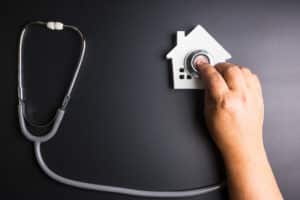Are You a Commercial Property Owner? Know the Facts About Sick Building Syndrome and HVAC
Indoor Air Quality Comes First

With community health issues at the forefront of the news for so long now, it has become second nature for many Americans to consider the health ramifications of a crowded room or busy airport. And yet, the reality is that protecting indoor air quality has been a concern within the HVAC industry for decades.
Consider “sick building syndrome,” a catchy name for the consequences that accompany poor air quality in commercial properties across the country. Whether it’s an increased number of employees out sick from respiratory illnesses, or tenants complaining of headaches, nausea or other unpleasant symptoms that linger when inside an office, rental apartment, or the lobby, the mere suggestion of “sick building syndrome” by definition requires immediate action before things get worse. Understanding what’s causing the problem, and how to eliminate it should be mission critical for any commercial building owner.
The Environmental Protection Agency defines three major sources for air contamination:
#1. Ventilation: When Saving Energy Becomes Unsafe
It started with the push for energy conservation, itself a response to higher utility costs, in the 1970s. Many commercial buildings were constructed with less-than-ideal ventilation standards, resulting in fewer air changes per hour. This in turn translated into poor indoor air quality, with tenants, employees and residents of these buildings complaining of everything from more frequent headaches to decreased workplace productivity. Today, folks at the Center for Disease Control report that improved indoor ventilation is linked to reduced virus transmission, better indoor comfort and more. Indeed, industry watchdogs at ASHRAE, the American Society of Heating, Refrigeration and Air-Conditioning Engineers have determined precisely the right airflow rates for stores, offices, apartment buildings and schools, based on the size of the rooms involved and their occupancy patterns.
#2. Carpets, Off-Gassing and More
Many common materials used in furnishings, carpeting, and even cleaning products can leach unpleasant chemicals into the air long after they are first made or used. It’s called off-gassing, and it’s a problem, particularly in a poorly ventilated commercial building. While the smell of new paint or a bathroom spray may be familiar examples of this insidious problem, quite often off-gassing can occur even without a noxious odor.
Obviously, eliminating the use of any fabrics, paints, plastics, or cleaning compounds that emit these gases is ideal. Unfortunately, this solution is often cost prohibitive. Instead, commercial property owners can improve ventilation through better HVAC maintenance, and upgrades. Whether it’s getting ductwork inspected for dust and debris, replacing air filters or repairing leaky ductwork, a qualified HVAC specialist can help.
#3. Organic Contaminants: Assessment and Prevention
It’s always a good idea to address the source of leaks, standing water issues and other mold problems in order to preserve air quality. It will also prevent bigger problems from emerging down the line. And whether you decide to add a new UV air cleaner, or improve ventilation with more open windows, or just fix a broken economizer, thoughtful upgrades and sensible repairs can make the difference between a sick and healthy building.
We understand owning a commercial property is an expensive investment. That is precisely why appropriate HVAC maintenance, adhering to best practices for building operations, and even just greater awareness of “sick building syndrome” are important. Have questions? Get in touch today with an Air-Tro HVAC specialist. We can provide realistic solutions that will preserve the safety and integrity of your building, while protecting your budget, too.
Want to find out more about air purification systems for your commercial building? Call Air-Tro today at (626) 357-3535.
